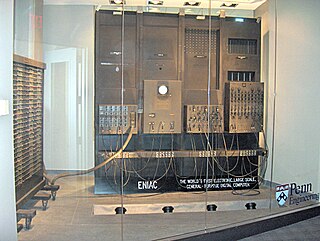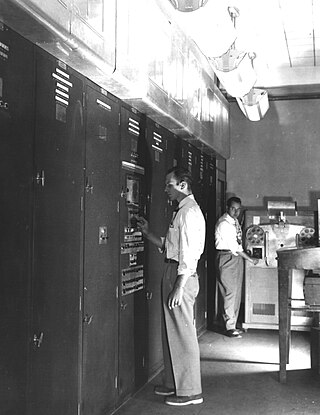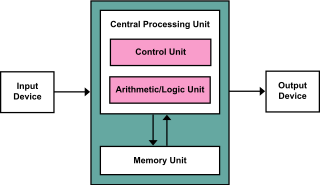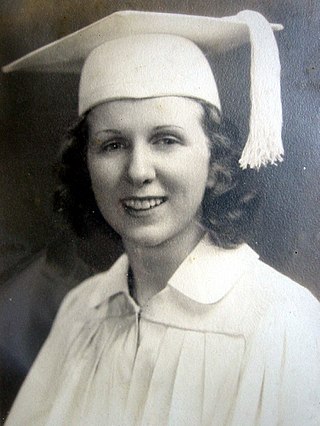
ENIAC was the first programmable, electronic, general-purpose digital computer, completed in 1945. There were other computers that had combinations of these features, but the ENIAC had all of them in one computer. It was Turing-complete and able to solve "a large class of numerical problems" through reprogramming.

John Adam Presper Eckert Jr. was an American electrical engineer and computer pioneer. With John Mauchly, he designed the first general-purpose electronic digital computer (ENIAC), presented the first course in computing topics, founded the Eckert–Mauchly Computer Corporation, and designed the first commercial computer in the U.S., the UNIVAC, which incorporated Eckert's invention of the mercury delay-line memory.

EDVAC was one of the earliest electronic computers. It was built by Moore School of Electrical Engineering, Pennsylvania. Along with ORDVAC, it was a successor to the ENIAC. Unlike ENIAC, it was binary rather than decimal, and was designed to be a stored-program computer.

John William Mauchly was an American physicist who, along with J. Presper Eckert, designed ENIAC, the first general-purpose electronic digital computer, as well as EDVAC, BINAC and UNIVAC I, the first commercial computer made in the United States.

The von Neumann architecture—also known as the von Neumann model or Princeton architecture—is a computer architecture based on a 1945 description by John von Neumann, and by others, in the First Draft of a Report on the EDVAC. The document describes a design architecture for an electronic digital computer with these components:

Herman Heine Goldstine was a mathematician and computer scientist, who worked as the director of the IAS machine at the Institute for Advanced Study and helped to develop ENIAC, the first of the modern electronic digital computers. He subsequently worked for many years at IBM as an IBM Fellow, the company's most prestigious technical position.
The First Draft of a Report on the EDVAC is an incomplete 101-page document written by John von Neumann and distributed on June 30, 1945 by Herman Goldstine, security officer on the classified ENIAC project. It contains the first published description of the logical design of a computer using the stored-program concept, which has come to be known as the von Neumann architecture; the name has become controversial due to von Neumann's failure to name other contributors.

Douglas Rayner Hartree was an English mathematician and physicist most famous for the development of numerical analysis and its application to the Hartree–Fock equations of atomic physics and the construction of a differential analyser using Meccano.

Harold Pender was an American academic, author, and inventor. He was the first Dean of the University of Pennsylvania's Moore School of Electrical Engineering, a position he held from the founding of the School in 1923 until his retirement in 1949. During his tenure, the Moore School built the ENIAC, the first general-purpose electronic digital computer, and began construction of its successor machine, the EDVAC. Pender also proposed the Moore School Lectures, the first course in computers, which the Moore School offered by invitation in the summer of 1946.
The Eckert–Mauchly Computer Corporation (EMCC) was founded by J. Presper Eckert and John Mauchly. It was incorporated on December 22, 1947. After building the ENIAC at the University of Pennsylvania, Eckert and Mauchly formed EMCC to build new computer designs for commercial and military applications. The company was initially called the Electronic Control Company, changing its name to Eckert–Mauchly Computer Corporation when it was incorporated. In 1950, the company was sold to Remington Rand, which later merged with Sperry Corporation to become Sperry Rand, and survives today as Unisys.
Herman Lukoff was a computer pioneer and fellow of the IEEE.
Adele Goldstine was an American mathematician and computer programmer. She wrote the manual for the first electronic digital computer, ENIAC. Through her work programming the computer, she was also an instrumental player in converting the ENIAC from a computer that needed to be reprogrammed each time it was used to one that was able to perform a set of fifty stored instructions.

Kathleen Rita Antonelli, known as Kay McNulty, was an Irish computer programmer and one of the six original programmers of the ENIAC, one of the first general-purpose electronic digital computers. The other five ENIAC programmers were Betty Holberton, Ruth Teitelbaum, Frances Spence, Marlyn Meltzer, and Jean Bartik.

Frances V. Spence was one of the original programmers for the ENIAC. She is considered one of the first computer programmers in history.
Honeywell, Inc. v. Sperry Rand Corp., et al., 180 U.S.P.Q. 673, was a landmark U.S. federal court case that in October 1973 invalidated the 1964 patent for the ENIAC, the world's first general-purpose electronic digital computer. The decision held, in part, the following: 1. that the ENIAC inventors had derived the subject matter of the electronic digital computer from the Atanasoff–Berry computer (ABC), prototyped in 1939 by John Atanasoff and Clifford Berry, 2. that Atanasoff should have legal recognition as the inventor of the first electronic digital computer and 3. that the invention of the electronic digital computer ought to be placed in the public domain.
Theory and Techniques for Design of Electronic Digital Computers was a course in the construction of electronic digital computers held at the University of Pennsylvania's Moore School of Electrical Engineering between July 8, 1946, and August 30, 1946, and was the first time any computer topics had ever been taught to an assemblage of people. The course disseminated the ideas developed for the EDVAC and initiated an explosion of computer construction activity in the United States and internationally, especially in the United Kingdom.

Arthur Walter Burks was an American mathematician who worked in the 1940s as a senior engineer on the project that contributed to the design of the ENIAC, the first general-purpose electronic digital computer. Decades later, Burks and his wife Alice Burks outlined their case for the subject matter of the ENIAC having been derived from John Vincent Atanasoff. Burks was also for several decades a faculty member at the University of Michigan in Ann Arbor.

The University of Pennsylvania School of Engineering and Applied Science is the undergraduate and graduate engineering school of the University of Pennsylvania, a private research university in Philadelphia. The school offers programs that emphasize hands-on study of engineering fundamentals while encouraging students to leverage the educational offerings of the broader University. Engineering students can also take advantage of research opportunities through interactions with Penn’s School of Medicine, School of Arts and Sciences, and the Wharton School.
The Ballistic Research Laboratory (BRL) was a leading U.S. Army research establishment situated at Aberdeen Proving Ground, Maryland that specialized in ballistics as well as vulnerability and lethality analysis. BRL served as a major Army center for research and development in technologies related to weapon phenomena, armor, electronic devices, and high-speed computing. In 1992, BRL was disestablished and its mission, personnel, and facilities were incorporated into the newly created Army Research Laboratory (ARL).
John Grist Brainerd was an American electrical engineer who served as principal investigator on the project to build ENIAC, the first general-purpose electronic digital computer. Later, he was dean of the Moore School of Electrical Engineering at the University of Pennsylvania.














